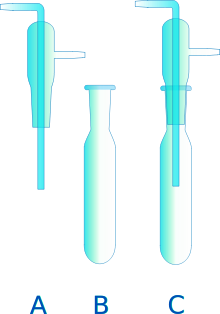- Cold trap
-
For the atmospheric phenomenon, see Cold trap (astronomy).Cold trap immersed in cold medium in Dewar flask. Some workers prefer the opposite arrangement, where vapors flow down the wall of the trap, and are sucked up the inner tube; this reduces blockage.[1]
In vacuum applications, a cold trap is a device that condenses all vapors except the permanent gases into a liquid or solid.[2] The most common objective is to prevent vapors from a vacuum pump from contaminating the experiment or sample of interest. Cold traps also refer to the application of cooled surfaces or baffles to prevent oil vapours from flowing from a pump and into a chamber. In such a case, a baffle or a section of pipe containing a number of cooled vanes, will be attached to the inlet of an existing pumping system. By cooling the baffle, either with a cryogen such as liquid nitrogen, or by use of an electrically driven Peltier element, oil vapour molecules that strike the baffle vanes will condense and thus be removed from the pumped cavity.
Contents
Applications
Pumps that use oil either as their working fluid (diffusion pumps), or as their lubricant (mechanical rotary pumps), are often the sources of contamination in vacuum systems. Placing a cold trap at the mouth of such a pump greatly lowers the risk that oil vapours will backstream into the cavity.
Cold traps can also be used for experiments involving vacuum lines such as small-scale very low temperature distillations/condensations. This is accomplished through the use of a coolant such as liquid nitrogen or a freezing mixture of dry ice in acetone or a similar solvent with a low melting point.
Cold traps are also used in cryopump systems to generate hard vacua by condensing the major constituents of the atmosphere (nitrogen, oxygen, carbon dioxide and water) into their liquid or solid forms.
Main article: cryopumpHazards
Care should be take when using a cold trap not to condense liquid oxygen (a light blue liquid) into the cold trap. Liquid oxygen is potentially explosive, and this is especially true if the trap has been used to trap solvent. Liquid oxygen can be condensed into a cold trap if a pump has sucked air through the trap when the trap is very cold, e.g. when cooled with liquid nitrogen.
Construction
Cold traps (C in the figure) usually consist of two parts: The bottom is a large, thick round tube with ground-glass joints (B in the figure), and the second is a cap (A in the figure), also with ground-glass connections. The length of the tube is usually selected so that, when assembled, the total reached is about half the length of the tube.
See also
References
- ^ Errington, R. M. (1997) (Google Books excerpt). Advanced practical inorganic and metalorganic chemistry. London: Blackie Academic & Professional. pp. 51. ISBN 0-7514-0225-7. http://books.google.com/books?id=yI_mq_mCf2AC&pg=PA42&lpg=PA48#PPA51,M1.
- ^ Laurence M. Harwood, Christopher J. Moody (13 Jun 1989). Experimental organic chemistry: Principles and Practice (Illustrated edition ed.). WileyBlackwell. pp. 41–42. ISBN 0632020172 ISBN 978-0632020171.
Categories:
Wikimedia Foundation. 2010.

